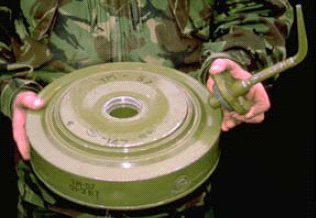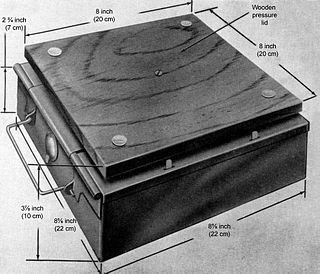
In anti-tank warfare, an anti-tank mine is a type of land mine designed to damage or destroy vehicles including tanks and armored fighting vehicles.

A shear pin is a mechanical detail designed to allow a specific outcome to occur once a predetermined force is applied. It can either function as a safeguard designed to break to protect other parts, or as a conditional operator that will not allow a mechanical device to operate until the correct force is applied.
The PP Mi-D mine is a Czechoslovakian copy of the German Second World War Schu-mine 42 anti-personnel mine.

The Schü-mine 42, was a German anti-personnel mine used during the Second World War. It consisted of a simple wooden box with a hinged lid containing a 200-gram (7.1 oz) block of cast TNT and a ZZ-42 type detonator. A slot in the lid pressed down on the striker retaining pin, sufficient pressure on the lid caused the pin to move, releasing the striker which triggered the detonator.

The PMD-6, PMD-7 and PMD-57 series mines are Soviet Union blast-type anti-personnel mines that consist of a wooden box with a hinged lid with a slot cut into it. The slot presses down against a retaining pin, which holds back the striker. When sufficient pressure is applied to the lid of the box the retaining pin moves, allowing the striker to hit the detonator. The mines typically have an operating pressure of 1 to 10 kg.
The POMZ, POMZ-2 and POMZ-2M are three types of Soviet-made stake mounted anti-personnel fragmentation mine. The POMZ mine was used during the Second World War. It was superseded by the POMZ-2, and later by the improved POMZ-2M. These mines have been used in numerous conflicts, including the Vietnam War and the Korean War.

The TM-57 mine is a large, circular Soviet metal-cased blast anti-tank mine. It can either be triggered by a pressure or a tilt-rod fuze. A development of the TM-46 mine, it is found in Africa, the Middle East, and South East Asia.

The TM-46 mine is a large, circular, metal-cased Soviet anti-tank mine. It uses either a pressure or tilt-rod fuze, which is screwed into the top. Anti-tank mines with this type of fuze were capable of inflicting much more damage to armored vehicles, when compared to a typical anti-personnel mine.
The TMD-44 and TMD-B are simple rectangular Soviet wooden box cased anti-tank blast mines, they were both used during the Second World War. Both mines are similar in design, differing only in fuzing mechanism. The wooden construction of both the mines makes them unpredictable as rot and insects can eat away the wooden case, reducing activation pressure to as little as 3 kg. Both mines are found in a number of countries including Afghanistan, Angola, Chad, Cuba, Egypt, Korea, Mozambique, Namibia, Rwanda, Yemen, Zambia and Zimbabwe.
The M7 is a small, metal-cased United States anti-tank blast mine that was used during the Second World War. It was based on the British Hawkins grenade. Approximately 2.5 million were produced before production ceased, and although it has long since been withdrawn from U.S. service, it can be found in Angola, Burma, Cambodia, Chad, Eritrea, Ethiopia, Korea, Lebanon, Myanmar, Somalia, Thailand, and Zambia.
The AT-8 or Cuban anti-tank mine is a square green plastic cased anti-tank mine. It is a scaled-up version of the Cuban anti-personnel mine. The mine consists of a plastic ribbed hinged upper case which rests on the fuzes placed into the lower plastic case. When enough pressure is placed on the upper lid the strikers are released from the fuzes. This triggers the main charge, which consists of up to twenty 400 g blocks of TNT. The mine is fitted with MUV or RO-1 type fuzes.

The TM-38 was a rectangular, metal-cased Soviet anti-tank mine used during the Second World War. The mine had a large raised rectangular central pressure plate with four reinforcing creases. When enough pressure was applied to the plate it collapses pressing down on a bolt connected to an internal lever. The lever pulls a retaining pin from the MUV fuze, which releases the striker, which impacts the MD-2 detonator.

The TM-35 was a rectangular, metal-cased Soviet anti-tank mine used during the Second World War. The mine has a metal case, which is rectangular with a carrying handle on one side and a large raised pressure plate in the centre. Sufficient pressure on the central pressure plate presses down on one end of an internal see-saw like lever, which removes the retaining pin from an MUV fuze, releasing the striker, triggering the mine.
The TMB-1,TMB-2, and TMSB were a round Soviet minimum metal anti-tank mines used during the Second World War. Both mines were similar in design, differing only in size, with the TMB-2 being the larger.

The T-IV was a Soviet anti-tank mine developed before and used during the Second World War. The mine has a metal case with a wooden pressure plate attached to the top of the mine. It is similar in configuration to the later TM-38.
The TMD-40 was a wooden-cased Soviet anti-tank blast mine used during the Second World War. The mine consisted of a rectangular wooden box which contained a detonator assembly at each end and seven 400 gram and four 200 gram blocks of explosive. The fuse assemblies consisted of a lever device, which when pressed downward by pressure pieces attached to the lid of the mine, see-sawed upward, pulling the striker retaining pin from a pull detonator. The main charge was then triggered.
The NV-41 was a wooden-cased Soviet anti-tank blast mine used during the Second World War. The mine consists of a square wooden box with a filling plug on the bottom. The top of the box is covered by a thin pressure lid, which covers a pressure plate held up by a spring. Sufficient pressure on the lid collapses it down onto the pressure plate. Downward movement of the pressure plate moves down a pressure plunger, which in turn levers up the striker retaining lever, releasing the spring-loaded striker and allowing it to impact the stab sensitive detonator, triggering the main charge.

The Holzmine 42 was an anti-tank mine that was developed by Germany and used by the Wehrmacht during World War II.

The B-Stabmine (Behelfs-Stabmine) or Makeshift Stickmine in English was an anti-tank mine that was developed by Germany and used by the Wehrmacht during World War II.
The Mine A.P. Improvised Type I was a British Anti-personnel mine of World War II.










